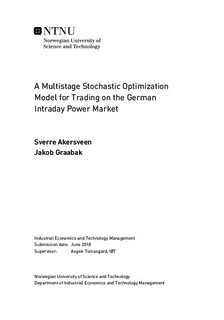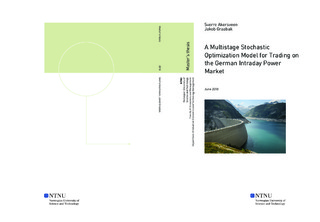| dc.description.abstract | As the German Intraday power market has grown steadily over the last seven years, the academic and commercial interest in mathematical optimization of decision making related to the market has grown. The relevant decisions include both production and trading of 24 hourly delivery products. The trading is organized as a Continuous Auction implemented as a Limit Order Book for each delivery product. The market opens soon after the clearing of the Day-Ahead market and closes just before delivery. As both the delivery products and the trading decisions for a given delivery product happen sequentially, the decision structure has a doubly dynamic trading structure that makes it hard to optimize. Additionally, the liquidity in the market is limited, further complicating the optimization.
Due to the high complexity of the problem, existing papers that attempt to optimize decision making related to the Intraday market make several simplifying assumptions. In order to find the best combination of modeling assumptions to make, an extensive literature review is performed, focusing on the modeling assumptions in each paper. It is found that there is disagreement in the contemporary literature about how to best model the problem. In particular, the relevant papers optimize either order placement in the market, or physical power dispatch, and neglect the other type of decision.
In this thesis, the Intraday Trading Problem (ITP) is defined to include both the order placement and the production optimization. The ITP is further broken down into three subproblems: the price forecasting problem, the cost estimation problem and the strategy formulation problem. Based on the points of disagreement in the related literature, a set of modeling assumptions is defined, mostly relating to the strategy formulation problem. The goal of the thesis is to explore which of the modeling assumptions that are the most profitable to make, and estimate the impact on the objective function of making a given combination of assumptions. Based on the set of modeling assumptions, a proposed benchmark model and six models inspired by the existing literature are defined. In order to test the model, a detailed analysis of historical EPEX Intraday order book data is performed, and a model of the market is developed. The estimation of all the relevant market parameters is a significant expansion compared to the market analyses performed in the existing literature. Small scenario trees are developed based on the market analysis, and the models are tested on a "forest" of semi-optimized, semi-randomized scenario trees. It is found that the proposed benchmark model outperforms the alternative models with a 4-41% premium on the objective value. Finally, the theoretical reasons for the improved performance is discussed, and three avenues for future research are outlined. | |

